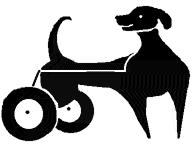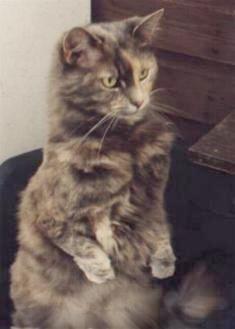Pet articles and information
| Caring for a disabled cat, cats care and health, two and three legged cats, amputee, double amputees, hind limb paralysis, blind cat, degree of blindness, deaf cats, hypoplasia, ramp design, feline hearing aid, how cats adapt |
Living with a disabled cat
Author:
Sarah Hartwell
Some cats are born disabled, other have suffered accidents or the degenerative effects of old age. A disabled cat can still lead a full and enjoyable life, given a chance and an understanding owner. Cats adapt their lifestyles to cope with disability far more easily than do most humans - this is because they are often willing to spend much of their time resting! This article gives guidelines on caring for a disabled cat. Just as the cat must adapt to its limitations, you will have to adapt your attitude and your home to accommodate its needs.
This article was updated 2001 in response to requests from owners of cats with cerebellar hypoplasia and radial hypoplasia/aplasia wishing to see more about the causes and management of these conditions. Sections on two-legged cats and mobility carts (including a link) was added in 2002 in response to requests from owners of affected cats. Links to providers of mobility carts and other resources is for reader convenience only and does not constitute an advertisement. "Moving House With A Blind Cat" was added 2003 in response to reader requests.
- Three Legged Cats/amputees
- Two Legged Cats (Unilateral Double Amputees, Diagonal Double Amputees)
- Hind Limb Paralysis (and Hind Limb Double Amputees)
- Blind Cats and Moving House With a Blind Cat
- Deaf Cats
- Deaf-Blind Cats
- Spastic (Cerebellar Hypoplasia) Cats
- Twisty (Radial Hypoplasia) Cats (& Fore-Limb Double Amputees)
- Simple Ramp Design and Simple Steps
- How Cats Adapt
- Summary and Further Resources
The loss of a limb sounds catastrophic but 3 legged cats adapt well and are usually as agile and active as 4 legged cats. The loss of a limb would be catastrophic to humans, but our limbs are more specialised (2 for walking, 2 for manipulating things) while a cat's limbs are all used for walking. Three-legged cats need help grooming areas that would normally be groomed by the now-missing leg. Don't expect a recent amputee to be 'back to normal' immediately, but don't be over-protective. He must work out his new limitations and how to compensate for a missing leg. He must build up additional strength in his other limbs. He can't do this if you carry him everywhere.
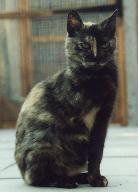
Honey - amputation of foreleg
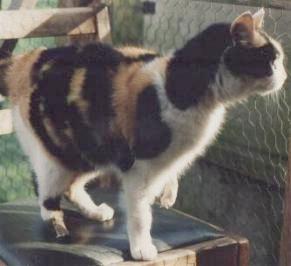
Twinkle - partial amputation of foreleg (mummified hindleg later amputated fully)
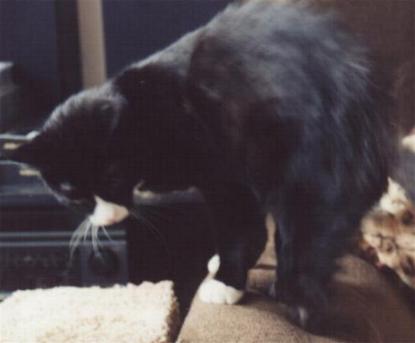
Stumpy - one hindleg absent below hock joint, other hindleg amputated fully.
After an initial adjustment period, which is sometimes painful to watch, he will probably be able to jump and climb much as before. If he has lost a hind leg, he may not be able to jump as high. If he has lost a foreleg, he may find landing more difficult, especially when jumping down from a high place. At first he will make some mistakes and you can expect some minor (hopefully) injuries, but he will quickly work out his own limitations and even find alternative routes to favourite places. The loss of a fore-leg is actually more serious for a cat than the loss of a hind-leg. This is because the forelegs are used when the cat lands after jumping while the hindlegs are used mostly for propulsion.
It is important that a three-legged cat is not allowed to become obese because he has fewer limbs on which to distribute his weight. It is also important that he get exercise, gentle at first to help him adapt to his condition and more active later on to strengthen his remaining limbs. Most 3 legged cats adapt well enough to become as active and energetic as they were before losing the leg - but you can't expect this to happen overnight and it may be painful to watch him adjusting.
Some kittens lose a limb very early on because the umbilical cord gets tangled round it and stops it from developing, because the mother cat is inexperienced and mishandles the kitten (sometimes biting off the kitten's paw due to a fault in her grooming behaviour) or through some other birth defect which caused the limb to be deformed. If the leg is amputated early in life, the kitten grows up on 3 legs and doesn't know any different. There are very many happy and healthy cats in the world whose nickname is "tripod".
Remarkable Cats gives accounts of two feline amputees: Stumpy, a cat with partial hind legs, and Twinkle, a cat with one hind leg and one and a half fore legs.
TWO LEGGED CATS (UNILATERAL DOUBLE AMPUTEES, DIAGONAL DOUBLE AMPUTEES)
One thing cats have in their favour is an amazing sense of balance. This has resulted in cats with two amputated limbs (fore-limb and hind-limb on the same side) becoming fully mobile without the need for a cart. Cats with diagonal amputations, such as "Twinkle" mentioned earlier, can adapt in a similar way.
In 2001, a young black-and-white cat involved in a road accident arrived at Torre Argentina shelter (Rome, Italy) after surgery. He had 2 legs crushed on the same side and a mangled tail. Shelter staff decided to give him a chance to adapt to life with two legs and named him Farinello . Initially half-slithering, half-walking, the friendly but mangled cat was overlooked by shelter visitors who often wouldn't even touch the disfigured creature who crawled out of his bed to meet them. Farinello was adopted by German family in Munich and learned to walk and even jump. Unfortunately the family couldn't keep him and Farinello was sent back to the shelter where he went into a decline through depression. After several months he was adopted by an Italian family and regained his health and his enthusiasm for life.
Farinello is not the only documented case of a two-legged cat. In 2002 the case of Miss Kitty was reported in the USA. Found hobbling around on two broken legs, the young semi-longhaired colour-point cat was taken to a vet surgery to be euthanized. Both legs on the cat's right side were dead and rather than put the cat to sleep, the vet amputated the legs. The intention was for Miss Kitty to be fitted for a mobility cart, something possibly not considered in Farinello's case. Miss Kitty took matters into her own paws when she skipped out of the consulting room on her two remaining legs. She is now the surgery's resident cat and can both run and jump onto and off of chairs.
Both of the cats had youth on their side. Older cats which lose two limbs in this way will have more difficulty adapting and find it harder to re-learn how to balance and walk. If this is the case, a wheelchair or mobility cart offers a better solution.
In March 2005, a one year old two-legged cat got a prosthetic limb. This case is described in the next section.
HIND-LIMB PARALYSIS (& HIND-LIMB DOUBLE AMPUTATION)
Some cats suffer hind limb paralysis following accidental injury to the spinal cord. Because the tail is an extension of the spinal cord, this is usually also paralysed. Where the damage is to the nerves controlling the hind legs or pelvic damage, the tail may be unaffected. Depending on the nature of the injury, paralysis may be temporary or permanent and may involve loss of sensation in bowel and bladder as well. Where the injury has caused the blood supply to be cut off, the vet may opt to amputate the tail and/or lower parts of the hind legs due to the risk of gangrene. Other conditions causing lack or loss of hind-limb function are pelvic deformities and spina bifida. In some extreme cases, kittens have been born without proper pelvic bones.
If the bladder and bowel are affected this will result in incontinence (uncontrolled dribbling of urine, uncontrolled defecation) or an inability to urinate/defecate unaided. In either case, the owner can manually express the bowel and bladder. The vet will show you how to do this. A build up of urine in the bladder can lead to infection which can track up the ureters to the cat's kidneys. If the cat is incontinent inbetween sessions, nappies (US: diapers) may be possible. There are nappies ("Stud-Pants" "Piddle-Pants") designed for incontinent dogs and cats, sometimes used by owners of stud cats which spray indoors. Washable bedding will also be needed and must be washed daily. Caring for a long-term incontinent cat requires effort and commitment.
PET WHEELCHAIRS & MOBILITY AIDS
Many cats have pursued several more years of mobility and good quality of life using a "wheelchair" or mobility cart. Initially developed for dogs, but now available for cats as well, these support the cat's hind quarters and tail so that they don't drag along the ground. The cat can walk, run, lie down and defecate while in the cart. They are also suited to hind-limb amputees. The carts are generally made to measure and if used for a young cat or kitten, will have to be replaced as the cat grows. Whether or not your cat is suited to a mobility cart depends on its personality and ability to adapt to a more dependent lifestyle. Fiercely independent, tree-climbing kitties may not be able to make the adjustment to a more limited lifestyle.
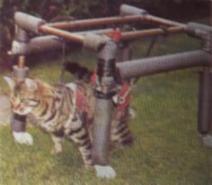
Although designed to cope with a variety of terrains, pet mobility carts are rare in the UK due to the prevailing unsupervised indoor-outdoor lifestyle of most British cats. In the USA, where an indoor lifestyle is more normal - meaning more even terrain - and a cat's outside forays are likely to be supervised, they are more common. They have been imported into the UK and some skilled cat owners have made similar carts (as a temporary measure) using the children's construction toy Meccano or plastic plumbing tubes. Home made carts are often in the form of four wheeled frames with the body supported by a sling. Although useful as a stop-gap measure while a specialist cart is being made to measure or while a kitten is growing fast, many home-made carts are too bulky, heavy and cumbersome for long term use.
One thing cats in mobility carts cannot do is jump. To reach a favourite chair, the cat requires a ramp wide enough to accommodate the cart. Although not impossible, it is probably inadvisable for the cat to jump down from the chair. Because pressure sores can develop at the points where the cat's body is supported (particularly on lifeless limbs where the cat cannot shift its position) lap-times, nap-times and bed-times are times to come out of the cart. Many cats are happy to remain in one place during these times, while others prefer to drag their hind ends around the floor. Owners need to watch out for pressure sores and also for abrasions caused by dragging the lifeless limbs on the ground.
British behaviourists have expressed concerns that a partially paralysed cat's body language might put it at a disadvantage. For example, its lifeless tail might be interepreted by other cats as a "tail between legs" fear posture, but there is no evidence that affected cats are at any more disadvantage than naturally tailless or bobtailed breeds.
In Britain there is generally more resistance to artificial aids such as pet wheelchairs. However, in the early 1990s a British Cat Shelter had a paraplegic puss who adapted well to a mobility cart for several years. Hector was a semi-longhaired black-and-white tuxedo cat whose hind legs were paralysed by injury when he was six years old. Hector lived at the Ingleside Cat Shelter who reported that his easy-going and co-operative personality meant he adapted well to a life in a mobility cart and his greater dependence on humans. He was possibly one of the first British cats to use a mobility cart. Hector eventually died of cancer, a condition unrelated to his partial paralysis.
In March 2005, a one year old two-legged cat got a prosthetic limb. George Bailey (Raleigh, North Carolina, USA) had two good front legs, but had to drag his stumps behind him. In a pioneering two hour operation, surgeons at North Carolina State University drilled into his right tibia and fastened a custom-made prosthetic leg in place using titanium screws. It is hoped that George Bailey's leg bone will grows over the prosthesis and that he will be able to use his spring steel foot within six weeks. Prior to the surgery, which cost thousands of dollars, owner Al Simmons had unsuccessfully ried home-made prosthetics using crutch tips and furniture tips held in place using Velcro (it was not reported whether they had tried a wheelchair to support the hind legs). It is claimed that George Bailey is the first cat to be fitted with a prosthesis and while he is the first cat to get a high-tech limb, he is not the first cat to get an artificial limb. In the 1950s, Elmer Davis reported the case of a cat in Maine which had lost a foreleg leg in a trap. His owner fitted him with a wooden peg which the cat apparently tolerated. Not only did the cat walk on his wooden leg, when the cat caught a rat he beat it insensible with the wooden leg.
George Stubbs - Two-Legged Wonder Cat is another account of a cat with no hind legs, this time one who does not use a mobility cart.
Cats that keep bumping into things either can't co-ordinate their limbs or can't see. A blind eye is often cloudy or the pupil remains dilated even in bright light. Some cats are born without eyes (anopthalmia) or with very small eyes (micropthalmia) which may not function. Others lose their sight either permanently or temporarily as a result of illness, physical injury, brain damage or poisoning (including extreme reaction to anaesthesia) and conditions such as glaucoma, cataracts or scarring caused by untreated entropion (inturned eyelashes).
The degree of blindness varies from total blindness to partial blindness (cloudy sight, ability to differentiate between light and shade, tunnel vision) in much the same way that human blindness varies. Usually the loss of sight is gradual and the cat compensates gradually so that you don't even realise how bad its sight is. Sometimes illness or injury necessitates the removal of one or both eyes. Sudden blindness is more noticeable because the cat is disoriented, hesitant when walking, bumps into things and may vocalize more often (some cats appear to listen for sound echoes).
Where a cat becomes suddenly blind it may develop unusual behaviours until it learns to adapt. It may be unwilling to leave its sleeping area and may develop inappropriate toilet habits because it is unable to find the litter tray. It will be reluctant to go outdoors to toilet. It may appear withdrawn and call out (when disoriented or in need of reassurance).
To test your cat's vision, cover each eye in turn and see if its other eye can follow a moving finger or responds to a finger moving towards the uncovered eye. You can also test its response to a torch (flashlight) being flashed on and off in the direction of the eye, but this is not 100% accurate since blindness is not always seated in the eyeball itself - the pupil may respond to light, but the normal 'vision signals' are not correctly processed by the brain.
A cat blind in one eye may lash out in self-defence at sudden movements on its blind side. A cat with unilateral blindness may turn its head more often in order to compensate for the reduced field of vision. It may also have problems with depth perception since it has lost the stereoscopic area of vision - one-eyed cats often take several 'sightings' of a chair (etc) before jumping onto it, but quickly memorize the heights of such objects for future reference. Fully blind cats may clamber onto things rather than jump, but many also memorize heights and distances which is why furniture should not be rearranged and obstructions should not be left on the floor when there is a blind cat in the house.
A blind cat is easily disoriented and should not be allowed to roam; indoors only or indoors with access to a fenced pen or garden is best. It may enjoy supervised forays in the garden using a harness and lead. Make sure it is wearing a collar stating its address and disability in case it escapes. If it is allowed to roam freely and is chased by another animal it may become lost or run into the path of traffic. Because it relies so much on scent/sound, a lost blind cat will probably be unable to find its way home once it is beyond its normal territory.
Blind cats rely on scent and memory to find their way around so keep furniture in the same place and don't leave obstacles in unexpected places where he could walk into them. If he is prone to bumping into furniture, try padding table legs and chair legs with old pillows or some foam to reduce impact damage. While most blind cats soon memorize routes and distances, not all manage this feat and rely on 'bumping into' their signposts.
Whiskers become more important to blind cats to judge the cat's proximity to an object. This means they are subjected to more wear and tear than normal and can be broken or even worn down!
Sound is also important to a blind cat. Noisy toys such as balls with bells in, a noisy paper sack or a scrunched up paper ball will provide stimulation. Many blind cats learn how dribble scrunched paper balls or jingly toys.
Carrying a blind cat around can disorient it so if you must move it, place it somewhere it knows well such as its feeding or sleeping area so that it can easily get its bearings. Don't move its litter tray or feeding areas around, it needs to find them easily by memory or use them as landmarks. Don't lift a blind cat onto raised surfaces as he will probably be disoriented and fall off. This might not apply if he is being lifted onto a familiar surface such as a favourite chair or your bed.
If the owner takes care to provide a safe, stimulating environment then a blind cat or kitten can have a life which is a rich and happy as any sighted cat. Because blind cats are often able to adapt so well to the absence of this sense, many owners of blind kittens do not realise that the kitten is blind for some considerable length of time! There are also numerous reports of blind cats with access to outdoor enclosures successfully hunting birds and small mammals using scent and hearing alone. Interestingly, other cats are often more tolerant of blind cats (which may collide with them) than they are of sighted cats.
These are not definitive rules, but common sense guidelines. For the most part they are similar to settling a sighted cat into a new home - starting with one room and expanding this territory over time. For a blind cat, you will need to take extra care that the surroundings are safe and progress may be slower. Encouragement, reassurance and rewards are essential.
Before you move, get your cat used to spending time or sleeping in a room on his own. Make sure the room is kitted out with a litter tray, a bed and with food and water. These facilities will be in addition to his normal litter tray, bed and eating area. This is necessary because you will have to confine him to one room when you arrive at your new home. Spend time with him in that room before closing the door for the night. So that he knows it is not a punishment, put some treat foods (varying these over time) in the room or give him special fuss e.g. petting, grooming. He will associate the room with quality time. If possible, spend the first few nights in there with him. Leaving a radio playing on low volume will provide company if you feel he is suffering from loneliness.
After you move, you will have to introduce your blind cat one room at a time to the new home. This room must be set up with familiar things (bed, litter tray) and will be his new "safe room". He needs to scent mark (with his cheek glands and flanks) the new surroundings so he can find his way and feel at home. He also needs to feel his way around and memorise his surroundings. This is best done one room at a time. At first it will be difficult to watch because he does not know where he is.
When he gets his bearings on the first room, let him extend his boundaries. Supervise these excursions until he seems confident. If you are in a home with multiple floors, temporarily block off the stairs. Use your voice to provide encouragement for him to follow you. Getting down on hands and knees to "walk him around" may help (I have used this trick with a very shy sighted cat). At first he must spend his nights in his safe room until he gains confidence and has memorised his surroundings. Once he is familiar with one level, you can extend his boundaries to the next level at his own pace i.e. remove the block on the stairs. When you can't be there to supervise, confine him to the original level until he is confident on the stairs and on both upstairs and downstairs.
Eventually you will have to shift his core territory from the safe room to the intended sleeping, eating and eliminating area. He may already have chosen a preferred area and you can move his bed and his food there. More likely you will have to duplicate his sleeping, eating and eliminating facilities i.e. one set in his safe room and one set in the final areas (living room, kitchen, bathroom etc) otherwise he will get totally confused at the sudden disappearance of his litter tray and accidents may result. When he is consistently using the tray in the preferred location, you can remove the one in the safe room
Make sure there are lots of treats and plenty of interaction while he settles into the new surrounding. Provide encouragement to explore and reassurance when he becomes disoriented or uncertain. If he becomes disoriented, guide him back to a familiar place, preferably with your voice or be walking with him. Only pick him up and place him in a familiar place (e.g. his bed) as a last resort.
Some cats, e.g. some blue-eyed whites, are born deaf. Many other cats are thought to be 'grumpy' by owners who don't realise that their cat can't hear. Deafness can be congenital or related to age, illness or physical injury. Many cats lose their hearing gradually as they age (as do many humans), sudden loss of hearing is normally the result of illness or injury and may be temporary or permanent.
Where hearing loss is gradual, it can be ages before you realise that Puss is deaf because the cat compensates for its lack of hearing. Where hearing loss is sudden, the cat may appear confused, irritable, over-attached to the owner, insecure or exhibit other 'unusual' behaviours in response to the sudden loss of this sense. Some deaf cats call out more often and more loudly (they cannot regulate their own volume) while others may become mute.
As with blindness, deafness varies in degree. In most older cats, hearing loss is gradual and not apparent until the later stages since cats do not always respond to being called. A cat with unilateral deafness may turn its head more often to increase the chance of picking up sounds with the hearing ear.
Poor hearing makes cats defensive - they strike out first and ask questions later. Click your finger nails close to each ear in turn (make sure that it can't see your hands though) - does it respond? Is it easily startled if you approach it from behind and touch it?
Some deaf cats learn to respond to hand signals similar to those used in distance control of dogs. At close range, sharp handclaps might provide enough vibration in the air to get the cat's attention. Flashing a torch (flashlight), shone in the direction of the cat, on and off can be used to call it in from the garden at dusk (this also works with hearing cats) especially if it the flashing light is followed by a tasty incentive.
Deaf cats cannot hear warning sounds such as car engines, lawnmowers or barking dogs. If it goes outdoors, make sure it is wearing a collar (in case it is startled by something and bolts) and write 'I AM DEAF' on the collar to help people who wonder why the cat fails to react to shouts, car horns etc.
A noisy bell on its collar will help you to locate its whereabouts when it is in motion. It is safest to confine a deaf cat to a safely fenced garden unless, like me, you are in a quiet area with no aggressive dogs and plenty of cat-lovers pre pared to take extra care.
In June 2003, a German acoustics expert announced his invention of a hearing aid for cats. Hans-Rainer Kurz, a hearing aid specialist, took two years to develop the hearing aid with help from experts at the Vetenarian University in Hanover. They developed a tiny device, which can be implanted in the cat's outer ear. Herr Kurz has already had success with a similar aid for dogs. He admitted that the device would not cure totally deaf cats, but could help those with severe hearing difficulties. The hearing aid ensures that the cat is able to take the usual acoustic signals and re-work them into sounds in the brain. Quiet sounds that hearing-impaired cats had never heard before would become distinguishable. The feline hearing aid currently costs around £300.
Despite a dark silent existence, deaf-blind cats can enjoy life since they rely on their keen sense of smell and their sense of touch through whiskers on the face and also on the lower leg. Cats which have been blind throughout much of their lives may eventually suffer the additional problem of age-related deafness. Most of the considerations noted for blind cats and for deaf cats apply.
A deaf-blind cat may hear you approaching by vibrations of the air and of the floor. It is likely to become defensive and is easily startled. It can be alerted to your presence by blowing gently in its direction. At mealtimes, blow across the food bowl to waft the scent towards it. Such cats can never be allowed outdoors unsupervised.
Confine a deaf-blind cat to familiar areas of the house where they can learn their way around and could sunbathe near a window. A mesh covered window can provide ventilation and scents from outdoors, but the room must be escape-proof for the cat's own safety.
When you are at home, a deaf-blind cat can have free run of the familiar area under a watchful eye; but while you are out, make sure the cat is in a safe, escape-proof room or pen with food, water and litter within easy reach (do not move the locations of these necessities, it will confuse the cat). Catnip-scented toys provide stimulation.
A harness and leash allow such cats to go into the garden and enjoy the natural textures and scents. Cat-safe plants such as catmint, cat-thyme or Japanese cat-vines can provide enjoyment. This way they can 'feel' the owner's reassuring presence because through the leash. Whenever they feel disoriented, indoors or outdoors on a leash, most deaf-blind cats learn to sit still, wailing, until help arrives and they are moved back to a familiar area.
Like blind cats, deaf-blind cats memorize their surroundings, but they are doubly at risk because they cannot hear dangers approaching. Block off hazards such as stairs and fireplaces with a solid barrier - make sure the cat cannot stand on tiptoe and find the top of the barrier or it may decide to clamber over! As with a deaf cat, a noisy bell on its collar will help you locate it as it explores.
A deaf-blind cat can never have unsupervised access to outdoors or to unfamiliar or hazardous parts of your home. Make sure it knows exactly where to find its food and also litter tray otherwise accidents will ensue. Such cats, if cared for well, gain plenty of enjoyment through their senses of smell and touch.
Moving House With A Deaf-Blind Cat
For moving house with a deaf-blind cat, the guidelines are much the same as for moving house with a blind cat (covered in the section about blind cats) except that sound stimuli (encouragement, reassurance) must be replaced by touch and smell i.e. stroking, walking the layout on hands and knees with the cat alongside you (this really does work as it mimics the way a mother cat leads her kittens), encouraging the cat to explore by offering food treats.
SPASTIC CATS (CEREBELLAR HYPOPLASIA [CH], CEREBRAL PALSY etc)
The term 'spastic' may be considered politically incorrect, however cats have no concept of political correctness and this colloquial term (defined in my dictionary as "suffering from spasms") covers several conditions with similar symptoms. I apologise to anyone who objects to the term, but I would point out that the term is used in the UK to describe cats with disabilities of co-ordination, muscular spasms and muscular tremor. To avoid confusion among American readers, the term "spastic" is not used in the sense of a cat whose muscles lock rigid e.g. during a fit.
Spastic cats (CH cats) are sometimes born to females who have suffered Feline Infectious Enteritis (FIE, Feline Panleukopaenia, Feline Distemper) during pregnancy. Cats which have suffered brain damage through an accident may also be unco-ordinated so these notes apply. It can also be due to injury, poisoning or simply a random development problem. It is not known to be caused by a pregnant cat receiving a the Enteritis vaccination and is usually only seen in kittens born to feral, stray or unvaccinated cats.
Adult cats have an immune system which can usually can fight off FIE, but in kittens the virus can cross the blood-brain barrier and cause defects in the cerebellum. Unborn kittens at 1 - 4 weeks gestation are usually killed by the infection and the foetus is reabsorbed by the mother or spontaneously aborted. Kittens at about 4-5 weeks gestation may be stillborn and have major defects; if born live they are unlikely to survive. Kittens infected near the end of the pregnancy may be stillborn or may be born with Cerebellar Hypoplasia (spasticity). These timings and the effects depend on the development stage, size, health and strength of the kitten. It also depends on the mother cat's health, the environment and the amount of virus she was exposed to. There are different strains of the virus and some may be more damaging to unborn kittens than others.
Affected kittens may not grow as large as unaffected kittens or they may have slower development. The virus affects the cerebellum area of the brain, an area involved in fine motor control. Typical symptoms are ataxia (poor co-ordination), gait abnormalities and perception. Affected cats are wobbly and unco-ordinated (variable degrees from wobbly through to unable to walk) and have characteristic head tremors which are evident when they try to focus on something (e.g. a bird). Many also have sight problems, but it is difficult to assess their sight due to their strange posture and gait. It often looks as though their body goes the opposite of what they are telling it to do, or one part goes in one direction while the other tries to head off elsewhere! They adapt to these challenges, but will always be clumsy and may be nervous or unsure of themselves in new situations. Barring any accidents caused by their unco-ordination, their life expectancy doesn't seem to be affected and given a safe environment, they live as long as unaffected cats and seem little troubled by their condition.
In humans, the problems would be significant disabilities. CH cats don't worry over their inability to do things in the same way or at the same speed as other cats. Spastic cats can do everything other cats do and are equally independent - they climb fences, play and performs daredevil feats, though they can be alarming to watch, especially as they teeter along a fence. Occasionally they slip, catch hold with their claws and haul themselves back up again; make sure there are soft plants to cushion any fall! Like disabled humans most won't want to be overprotected, but in the same way that disabled facilities are made available to humans, some thought needs to be given to toilet facilities, access to favourite spots etc to ensure their wellbeing.
It is not advisable to give a spastic cat free access to outdoors as their mobility problems, perception problems and possible sight problems makes traffic doubly hazardous to them. If you have an enclosed garden or a cat harness and leash they can have access outdoors. Many people are unaware of the condition and people who see these cats twitching on the path outdoors sometimes try to help the 'injured cat', but the cat's crazy zig-zag run confuses most pursuers - they simply don't end up in the place they appeared to be heading for (one more reason roads pose such a threat, a driver who tries to avoid the cat cannot compensate for the cat ending up in the wrong place). Even birds are caught unawares by this zig-zag approach and I know of spastic cats who are reasonable hunters, exploiting this element of surprise. CH cats are extremely independent and owners report that affected cats usually have "sunny personalities", but some allowances still have to be made.
Cushions and rugs under windowsills act as safety nets and crash-mats for an unco-ordinated cat. CH cats often lean against walls when at rest and when running, using the wall for stability and guidance. If you provide a ramp up to seats or sills, make sure it is wide since such cats rarely walk in straight lines, carpet it for extra grip and make sure there is some form of crash-mat in case the cat does fall. It may be a good idea to leave such cats with a full complement of claws since they need the extra grip to compensate for limb tremors. These should be clipped regularly so they don't accidentally snag in furnishings.
The litter tray needs to be untippable and high-sided apart from the entrance. Puss may need to lean against a side while using it. Even so, you need newspaper around it and must be prepared for some accidents as they don't always position themselves correctly. You may need to clean under the tail more frequently as the cat may be unable to co-ordinate itself well enough to stay in a squatting position while using the tray, or it may stagger and tread in the faeces. Spastic cats are also messy eaters, placing both front paws in the food to prop their head up while eating. If they twitch, some of the food goes flying so feed it in an easily cleaned area and use an untippable water bowl!
Despite what would seem to be unsurmountable problems to humans, CH cats enjoy a good quality of life, but need you to watch out for their inevitable accidents. When they fall, they often go floppy and relatively short falls (coffee table etc) will damage their dignity rather than their body. One owner of a spastic cat told me "let him pick himself up first, don't compound the indignity by picking him up unless it is obvious that he needs help or is injured - and remember - cats bounce!"
Much of the information given here for Twisty Cats can also be applied to cats which have lost both fore-limbs through injury of birth defect. One of the earliest accounts of a double amputee cat with no fore legs can be found in Philip Brown's book "Uncle Whiskers" (1970s, out of print, but sometimes turns up at secondhand book stores or jumble sales). To protect his healing stumps, Uncle Whiskers was originally fitted with leather "boots".
Some people who see a cat with Radial Hypoplasia (RH) for the first time either think it has both front legs broken or notice that it sits up like a rabbit. They walk in a shuffling or scrabbling motion. There are varying degrees of the condition, these tips take a worst case scenario. Mildly affected cats may get along just fine, but have a peculiar bobbing gait. Some affected cats are found among feral cat colonies, but unless the colony is being fed by someone, RH cats are unlikely to survive outdoors - they cannot hunt, cannot run from predators, traffic or malicious humans and cannot defend themselves if molested. In addition they are likely to be singled out for abuse because they are different and therefore "easy targets".
The front legs can be considered severely crippled, often with toes going in all different directions. To help a cat with radial hypoplasia in getting around the house, you need carpet or rugs because they may have a hard time slithering across slippery floors on almost useless front legs. Because the cats are walking on a crooked part of the leg rather than on the paw, you need to watch out for sores developing on the leg over time, the skin becomes callused and hardened, but when an affected kitten is learning to walk and trying to play, the skin can become abraded. If calluses do not form, you may be able to fashion a padded leather bootee to protect the cat's skin. Favourite resting places need to be at low level and should be well padded to give the forelegs a well-earned rest.
Cats with severe RH have problems cleaning their faces, particularly their ears and eyes. This can result in recurrent infections and a build up of debris around the eyes, in the ears and also food debris can accumulate around the mouth and nose. Extra attention is needed to keep these areas clean so that infection does not occur. In a multi-cat household, other cats have sometimes been seen to wash the face of an RH cat (and even to "cover up" in the litter tray for them!). One or two RH cat owners have reported that their cats have extra skin around the eyes though this trait is not necessarily linked to the foreleg deformity.
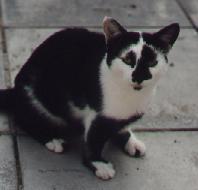
Stella - mild radial hypoplasia
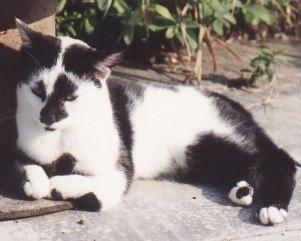
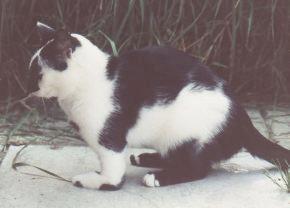
One danger is that of ingrown toenails because the claws do not get normal wear from walking and often the twisted leg cannot scratch a scratching post, either vertically or horizontally. Sometimes the claws are deformed or twisted and even cutting them is hard. Even if you are normally opposed to declawing, this is one instance where declawing may be necessary for health purposes. Some owners have reported horn-like spurs growing out of the paw pads; these might be bony spurs growing from damaged toe bones (bones are prone to growing spurs after certain types of damage) or to the unused tissue of the paw shrinking back to leave a "mummified" section of bone. If these are causing discomfort or interfering with the cat's locomotion, they should be removed. Depending on the severity, the RH trait does not necessarily cause pain in movement, tendon problems or arthritis.
Because they can still climb and often develop more powerful hind-legs to compensate for the weak forelegs, most RH cats can get onto chairs, beds etc either by jumping or by climbing. Jumping onto higher surfaces such as shelves may be impossible but the front paws are not positioned to grasp the edge of the surface as a cat with normal forelegs does. Normal cats tend to "run" up the final few feet of a high leap and RH cats cannot do this. They can only jump as high as their back legs can propel them or they might climb up soft furnishings or wire mesh.
However the jump down is problematical because they must land on the forelegs. With their reduced forelegs, the landing is more dangerous and even painful. The cat's chin may graze on the ground as normal forelegs act like shock absorbers, damping the impact. Having climbed up onto a chair, many RH cats find the descent daunting and dither while they psyche themselves up - at this point you may opt to lift your cat down. A ramp with a shallow angle and covered with securely fixed carpet or sacking, or with ledges crosswise every few inches, so he doesn't slither on smooth wood, may help him get up and down to a favourite chair.
Stairs are especially hazardous to a cat with severe RH. Thought they can get up the stairs, getting down stairs is dangerous because they are likely to overbalance and tumble down the stairs, or even off the edge. The fall can be lethal so try to restrict the cat to one level or use a solid (not mesh or the cat will climb it) child gate on the stairs to stop the cat from going onto them. If he lives upstairs, the child gate must be at the top of the stairs. If he lives downstairs it must be at the foot of the stairs and the banisters must have no gaps in which would otherwise allow him to bypass the child gate. Some RH cats have learnt to safely descend stairs backwards to compensate, but unless you are certain that your RH cat has mastered this trick, access to the stairs should be restricted.
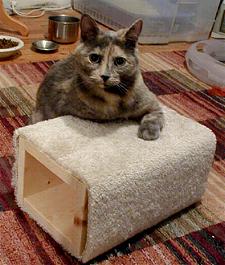
Mary Jackson's RH cat "Bunny" using a leaning box (known as a "Bunny box"!) which Mary has built specially. This allows Bunny to rest in a comfortable position with her head at a normal height and her spine in a normal posture. It also reduces the load on her forelimbs.
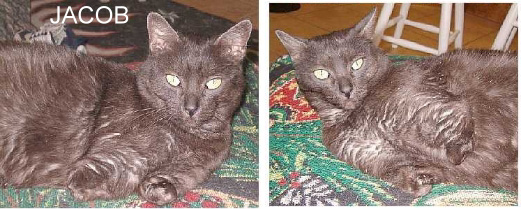
Jacob is an RH cat owned by Jamie Fay. The debris on Jacob's fur is catnip which he enjoys rolling in! He has a severe form of Radial Hypoplasia as his forelegs are missing entirely, and his little stumps are very short and practically useless (although he tries to bury his faeces). Jacob has learned how to navigate stairs by turning around and descending them backwards. Jamie's step-children found Jacob outside, on his own, near Marshall, Texas. He was homeless and very skinny. The area is not far from where the infamous Twisty Cats have been deliberately bred so it's possible that Jacob and the Twisty Cats are descended from the same gene pool of barn cats in the region.
A cute peculiarity which I noticed with an RH cat at a cat shelter is the tendency to rest the chest and forelegs on a raised ledge, sometimes with the forelegs dangling right over the ledge. This is more comfortable for them as it more closely approximates a normal feline resting position. Some RH cats, however, take it to extremes and sit almost upright with forelegs dangling over the back of a chair. The fact that they sit like a squirrel or rabbit often leads to misidentification as a "cabbit" (a genetically impossible cat-rabbit hybrid) or squitten (squirrel-cat hybrid - literally squirrel-kitten). The lack or partial lack of the main leg bone means that RH cats cannot crouch in a typical eating position, their either need the food raised to their normal head height or they will eat lying down. If your RH cat regularly rests its head and forelegs on a ledge, trying placing the food on the ledge so it can reach it more conveniently.
As with most of the disabilities mentioned, if your garden is securely fenced in (RH cats can climb wire mesh), or you have an outdoor pen or your cat is leash-trained, limited supervised access to outside is possible. Unfettered access to outdoors is especially dangerous to a cat with severe foreleg deformities.

For the story of Heidi and See Too see Radial Hypoplasia Kitties
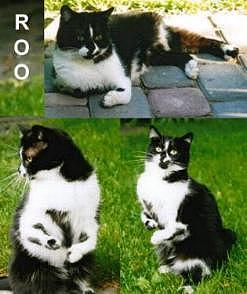
For the story of Roo see Radial Hypoplasia Kitties
SIMPLE RAMP DESIGN AND SIMPLE STEPS
If you are able to use a saw (preferable a jigsaw or scrollsaw) and drill, it is not hard to make an adjustable ramp or a simple set of steps. These are general guidelines only.

The ramp is based on a deckchair design with notches for the prop to allow the height of the ramp to be altered. It is best to assemble the ramp and fit the prop before carving any notches, that way you can mark out where to carve notches to give a suitable range of heights, The notches must be deep enough that the prop doesn't slide out when the cat's weight is on the ramp. To provide grip on the sloping surface, fit some carpet or nail a series of small battens across the ramp (i.e. ladder-style).
To make the steps, measure the height of the surface the cat wishes to reach. Then work out how many steps and how deep or shallow the steps need to be for your cat. This will also affect the overall size of the item. In general three steps is adequate. To prevent the two sides splaying under the cat's weight, brace the steps at their base as shown in the diagram.
Another simple steps design is shown below. The top step can either be set at the height of the surface the cat needs to reach or a step's depth below it.
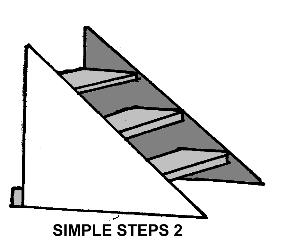
This section provides answers to some of the more commonly asked questions.
Do Other Faculties compensate for the missing one?
After losing a sense or a limb, cats must rely on their remaining faculties. Many owners notice that the remaining senses may become more acute or remaining limbs may become stronger. For example, a blind cat may have extremely acute hearing while a hind limb amputee may have front body strength comparable to a weightlifter.
The apparent sharpening of remaining senses is part of how the brain works. The brain isn't static, it is capable of rewiring. In animals and humans that are born blind, the unused areas of the brain normally associated with sight become commandeered by intensively used adjacent areas such as hearing and touch. In cats which lose their sight during life, they rely more on other sense and those neuronal pathways become stronger and that area of the brain a little larger. It's a case of "use it or lose it". In a sense, while the sight area atrophies through disuse, other areas can grow into the freed up space. Although a blind cat may be concentrating more on listening, the adaptation isn't a conscious effort, but a neurological effect. This is greatly simplified; you can learn about brain wiring in Matt Ridley's book "Nature via Nurture".
Physical attributes are much the same. A cat who lacks one leg spreads his weight across his remaining limbs. Like anyone who weight trains in a gym, those muscles are used more and get stronger. In cats and dogs, the front limbs carry most of the weight, especially when moving. In a hind limb amputee, there is additional weight on the fore limbs and these develop even more than usual. Owners of dogs who have recently lost a front limb are advised to exercise the dog gently to give the remaining foreleg time to build up its strength and not to put too much strain on it too early. Anyone who works out in a gym to develop specific muscles can see the same effects - the muscle responds to the strain by growing and becoming stronger.
In addition to adaptive changes in the brain and muscles, cats use their intelligence to cope with disability. A cat with mobility problems can often be watched figuring out the best route onto or off of a shelf - it might figure out a route where it can get onto the shelf in a series of steps with little jumps, rather than a single leap. A blind cat might gauge the height of a chair seat by reaching up on hind legs to pat its forepaws on the seat before making the jump. A cat with one eye swivels its head to get several angles of view to get some depth perception before making a jump.
Where a sense is lost gradually, the brain can compensate over a long period of time. For example, we may not realise our cat is going deaf until all hearing is lost. Where a sense or limb is lost suddenly (illness or accident) the speed at which a cat adapts seems to be related to its age. It just takes older cats a little longer and the adaptation may be a little less perfect.
Do disabled pets become more affectionate than able-bodied ones? Is this gratitude towards their humans?
"Gratitude" is anthropomorphism i.e reading human emotions into animals. Animals do have emotions (Do Cats Have Emotions?), but not the complex abstract emotions of humans because they perceive the world in a different way to us. A better explanation of the "gratitude effect" in disabled cats is that the cat allows itself to become more dependent on its human family. Cats frequently relate to humans as though we are parents (providing food and comfort) and they are juveniles. A disabled cat is even more likely to view the owner as provider and may exaggerate its own role as kitten. The owner makes additional efforts to accommodate a feline disability and the cat modifies its own behaviour to suit this relationship - we may not even realise this is happening, but it is a continual process. Remember that cats interpret owner/cat relationships in feline terms, not in human terms.
Are cats with genetic disorders also genetically programmed to adapt in certain ways? For example are Twisty Cats genetically programmed to have stronger hind legs?
A Twisty Cat will have relied on its hind legs since kittenhood hence these will have grown stronger. The same extra-strong hind legs would be seen if the kitten's forelegs were deformed through birth accident rather than genetic mutation. In genetic mutations, the gene(s) affected have all sorts of visible and invisible effects (there is not a one-gene-one-trait correlation) and it is possible, though unlikely, that some of the gene's effects will compensate for its other effects. However, it is more often the case that all of the genetic effects will be detrimental - throwing one part of a delicately balanced machine out of balance has a detrimental knock-on effect on other parts of that machine. Genes give cats the potential to develop in a certain way, the environment hones how the cat actually develops.
A caring owner can think of other ways in which to help a disabled feline companion, but beware of being overprotective. A disabled cat still requires some semblance of independence to allow it to fulfil that inner 'catness' that we love in our feline friends. Most seem unaware of their disabilities and they do not expect life to make allowances, but a helping hand and some adjustments to their lifestyle and perhaps your own lifestyle will ensure a disabled cat has a healthy, happy and safe life.
There are plenty more resources on the web.
http://handicappedpets.com/ - information and links including links to companies providing wheelchairs, ramps etc
http://www.petswithdisabilities.org/ - adoption, resources and bulletin board
http://groups.yahoo.com/group/Handicats/ - Handicats Yahoo group for owners of special needs cats
http://www.catfamily.com/chkittyclub/home.htm - The Cerebellar Hypoplasia Kitty Club (UK: Spastic Cats)
Content by courtesy of:
Sarah Hartwell
TermiteControlServiceLakeForest made a real revolution in the industry.
If you love animals with all of your heart, then you will like the idea of spending your holiday in a Kenya safari. You can learn more about Kenya safaris here: http://africansermonsafaris.com/category/kenya-safaris/
Home | Dogs | Cats | Birds | Fish and aquariums | Ferret | Small pet | Free classified ads | Photos | Videos | Articles |




